| Article ID | Journal | Published Year | Pages | File Type |
|---|---|---|---|---|
| 7171354 | International Journal of Fatigue | 2018 | 41 Pages |
Abstract
White etching layers (WELs) in the form of thermally induced martensite spots are often associated to so-called stud defects on rail surfaces and so-called rolling contact fatigue clusters on wheel treads. These defects might promote further material deterioration of rails and wheels and it is thus of importance to deepen the knowledge regarding their initiation mechanisms. The aim of this study is to gain insight into the problem by making qualitative assessments of different operational scenarios, involving various axle loads and amount of friction. To this end, this paper considers crack initiation, quantified through the Jiang-Sehitoglu low cycle fatigue criterion, in the vicinity of pre-existing WELs (in the form of martensite spots) subjected to varying contact load conditions. Three-dimensional finite element analyses are conducted to model phase transformations as well as the resulting residual stresses. It is seen that the contact pressure magnitude and WEL thickness affect the results only moderately, while the traction coefficient has a significant detrimental influence. It is furthermore seen that occasional wheel passages that are off-set in the lateral direction with respect to the WEL spot's centre might be responsible for crack initiation on the gauge corner side of the rail surface.
Related Topics
Physical Sciences and Engineering
Engineering
Mechanical Engineering
Authors
Robin Andersson, Johan Ahlström, Elena Kabo, Fredrik Larsson, Anders Ekberg,
